This Nikon-mount version is the equivalent of a 21-31mm and features a new optical design with 13 elements in 11 groups, and a minimum focus distance of 0.9 ft (0.28m). Tokina paid special attention to reducing chromatic aberration with the addition of four ED-type elements, two of which feature aspherical surfaces. The lens also features a large-diameter plastic-hybrid molded asphere in the front group to improve sharpness and reduce spherical aberration.
With an 82mm-diameter accessory thread, and measuring 3.5 x 4.2” (89 x 106mm), the lens is a little larger than what we’ve become accustomed to in the PRO DX range. It is also relatively heavy, weighing in at 1.60 lb (725g).
Although we’ve yet to test the lens on Nikon’s latest semi-pro models, we have analyzed it on the 24-Mpix Nikon D5300 and are delighted to share the results.
Measurements: Low lateral chromatic aberration and high sharpness
When tested on the still-current 24-Mpix D5300 body, the new lens shows very good sharpness, at least when stopped down. For a wide-angle zoom, it also has relatively good control of distortion and also of both low lateral chromatic aberration and vignetting. Optimum performance is achieved between f/4-5.6 at most focal lengths; however, there’s some astigmatism at f/4, which intensifies as the focal length progresses through the range. Although it has very high sharpness levels when stopped down, this lens is a little soft wide-open, even in the centers, but at least it is consistent across the field.
Comparison 1: Tokina AT-X 14-20mm F2 PRO DX Nikon vs. Tokina AT-X 11-20 F2.8 PRO DX Nikon vs. Tokina AT-X PRO SD 11-16 F2.8 IF DX II Nikon: Excellent overall performance
Tokina is gradually expanding its range of wide-angle zooms for the DX format. In addition to a moderate-speed 12-28mm (19-43mm equiv.) f/4, it has an 11-20mm (17-30mm equivalent) and a 11-16mm (17-25mm equivalent), both f/2.8. At $600 and $655, respectively, for the f/2.8 models, the 14-20mm F2 has a sizable pricetag for the faster maximum aperture, given the reduced range. Usually such high-fast lenses carry a penalty in terms of sharpness and chromatic aberration, but that’s not the case here. The 14-20mm has good sharpness wide-open at the wide end, with sharpness tailing off at 20mm (though it improves again noticeably when stopped down just one stop). It also has very low lateral chromatic aberration even at 14mm, where you would expect it to be problematic with a lens like this. Barrel-type distortion on the 14-20mm is, however, a little higher than on its wider siblings.
Comparison 2: Tokina AT-X 14-20mm F2 PRO DX Nikon vs. Sigma 18-35mm F1.8 DC HSM A Nikon vs. Nikon AF-S DX Zoom-Nikkor 17-55mm f/2.8G IF-ED: High sharpness
High-speed constant-aperture DX format lenses are still somewhat niche. Sigma was the first with an ultra-high-speed model, the 18-35mm F1.8 DC HSM A. Although not as wide, being the equivalent to a 28-54mm, the longer focal lengths make it a more general-purpose model, and therefore likely more attractive to a wider audience. It’s also a little cheaper at around $800. Nikon’s well-liked 17-55mm F2.8, equivalent to a 26-85mm, is a possible contender, but at around $1400, it’s hardly competitive as to price. Nikon’s diminutive AF-S DX Nikkor 10-24mm F3.5-4.5G ED, equivalent to a 16-37mm, is arguably a closer fit, especially with a price of $899, though the slower variable-maximum aperture is a drawback in this company. Unsurprisingly, perhaps, the wider Nikkor zoom is behind on sharpness and has noticeably higher levels of lateral chromatic aberration (though still low given the focal range). Nevertheless, it has only slightly more barrel distortion at its widest, while having lower pincushion from mid-focal lengths and up. It is a good performer, but inevitably, it is the Sigma that comes closest in terms of peak sharpness, with better performance at the initial aperture, particularly at 20mm, where the Tokina is weakest.
Conclusion
Although the range of focal lengths is somewhat limited, especially when compared with its closest rival, the Sigma 18-35mm (28-45mm equivalent) F1.8, the wider 14-20mm F2 (21-31mm equivalent) Tokina is an entirely different proposition. Indeed, with that f/2 maximum aperture, there really isn’t anything else to compare it with. If the choice of 21 and 24/28mm focal lengths appeal, then the Tokina’s optical performance won’t disappoint.


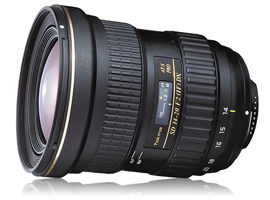


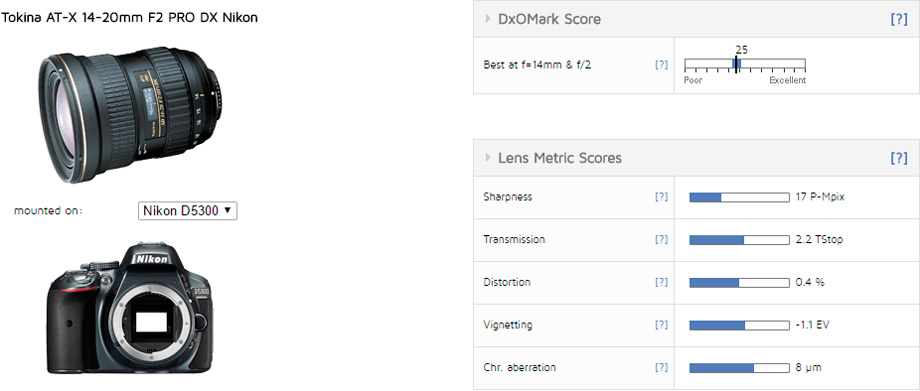
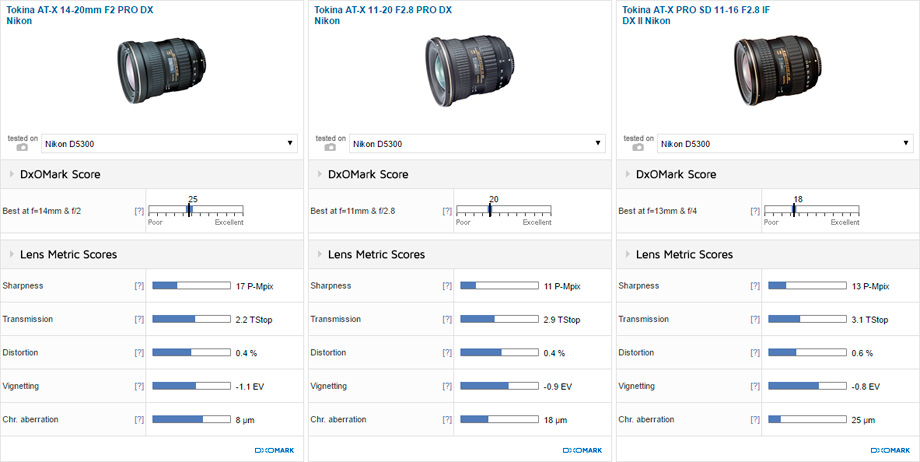
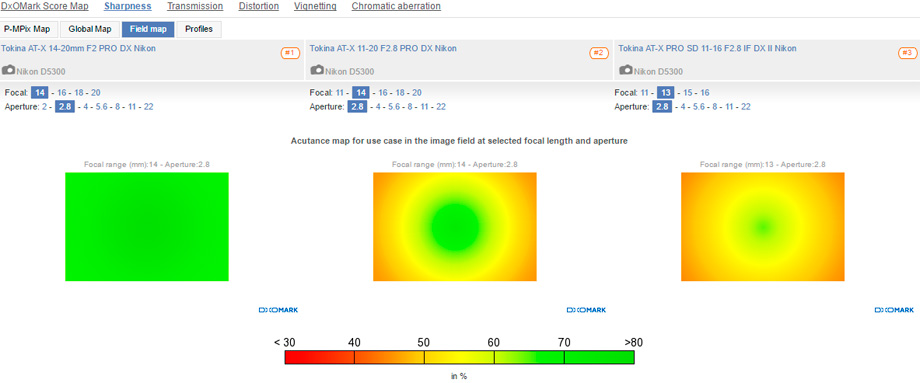



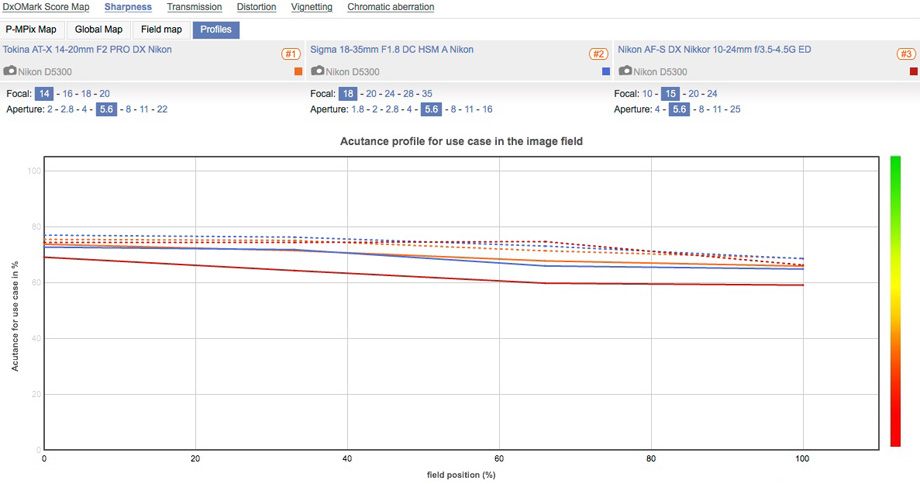

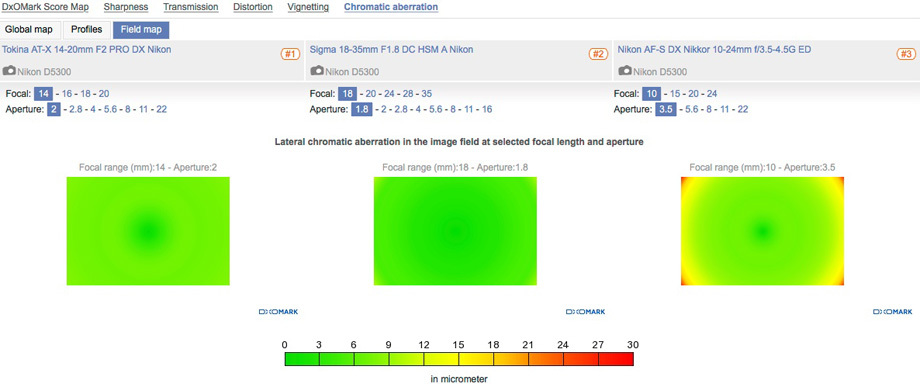
DXOMARK encourages its readers to share comments on the articles. To read or post comments, Disqus cookies are required. Change your Cookies Preferences and read more about our Comment Policy.